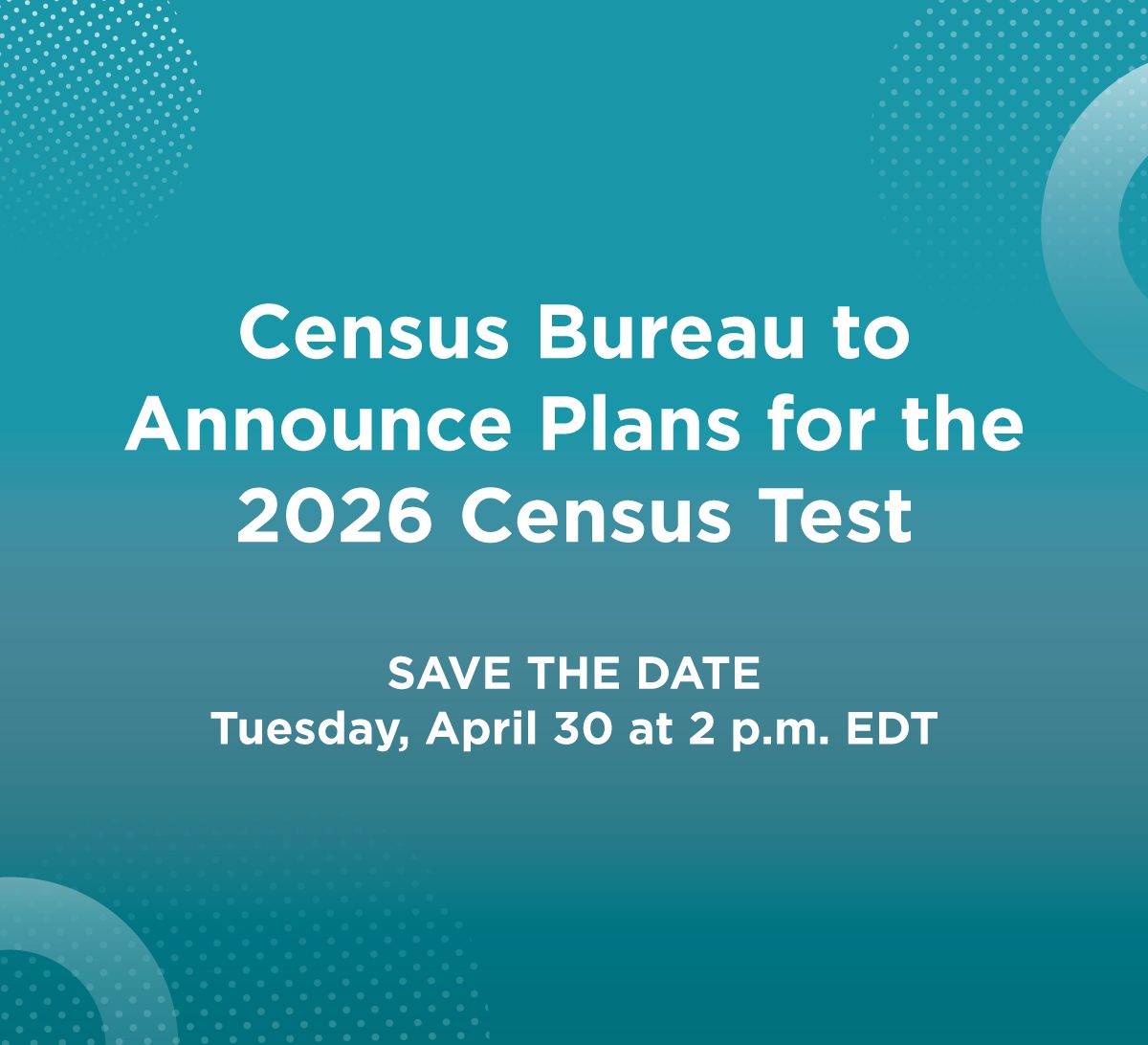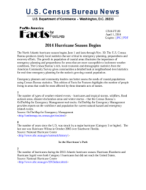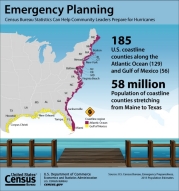Facts for Features: 2014 Hurricane Season Begins
The North Atlantic hurricane season begins June 1 and lasts through Nov. 30. The U.S. Census Bureau produces timely local statistics that are critical to emergency planning, preparedness and recovery efforts. The growth in population of coastal areas illustrates the importance of emergency planning and preparedness for areas that are more susceptible to inclement weather conditions. The Census Bureau's rich, local economic and demographic statistics from the American Community Survey gives communities a detailed look at neighborhood-level statistics for real-time emergency planning for the nation's growing coastal population.
Emergency planners and community leaders can better assess the needs of coastal populations using Census Bureau statistics. This edition of Facts for Features highlights the number of people living in areas that could be most affected by these dramatic acts of nature.
5
The number of types of weather-related events - hurricanes and tropical storms, wildfires, flood outlook areas, disaster declaration areas and winter storms - that the Census Bureau's OnTheMap for Emergency Management tool tracks. OnTheMap for Emergency Management provides reports on the workforce and population for current natural hazard and emergency related events.
Source: OnTheMap for Emergency Management
<//onthemap.ces.census.gov/em.html>
8
The number of years since the U.S. was struck by a major hurricane (Category 3 or higher). The last one was Hurricane Wilma in October 2005 over Southwest Florida.
<//www.nhc.noaa.gov/outreach/history/>
In the Hurricane's Path
2
The number of hurricanes during the 2013 Atlantic hurricane season. Hurricane Humberto and Hurricane Ingrid were both Category 1 hurricanes but did not reach the United States.
Source: National Hurricane Center
<//www.nhc.noaa.gov/2013atlan.shtml>
185
The number of coastline counties along the Atlantic (129 counties) and Gulf of Mexico (56 counties) most threatened by Atlantic hurricanes.
Source: Census Bureau Emergency Preparedness
<//www.census.gov/newsroom/emergencies/additional/additional_information_on_coastal_areas.html>
58 million
Population as of July 1, 2013, of coastline counties stretching from Maine to Texas.
Source: 2013 Population Estimates
<//www.census.gov/popest/estimates.html>
591,821
Collective land area in square miles of the states stretching from North Carolina to Texas. The states include Alabama, Florida, Georgia, Louisiana, Mississippi, North Carolina, South Carolina and Texas.
Source: 2010 Census
<//www.census.gov/geo/reference/state-area.html>
83 million
Population as of July 1, 2013, of coastal states stretching from North Carolina to Texas -- the areas most threatened by Atlantic hurricanes. An estimated 26.3 percent of the nation's population live in these states.
Source: 2013 Population Estimates
<//www.census.gov/popest/data/state/totals/2013/tables/NST-EST2013-01.xls>
1.8 million
The number of business establishments in 2011 in the coastal states (including Alabama, Florida, Georgia, Louisiana, Mississippi, North Carolina, South Carolina, and Texas). There were 27,932,189 paid workers in these establishments.
Source: 2011 County Business Patterns
<//www.census.gov/econ/cbp/>
10 Years Ago
9
The number of hurricanes during the 2004 hurricane season. Hurricanes Charley, Frances, Ivan and Jeanne were some of the notable storms during that year.
Source: National Hurricane Center
<//www.nhc.noaa.gov/outreach/history/>
73.3 million
Population in 2004 of the states stretching from North Carolina to Texas. Approximately 13 percent of the nation's population lived in these areas at that time.
Source: 2004 Population Estimates
<//www.census.gov/popest/data/intercensal/state/tables/ST-EST00INT-01.xls>
13%
Percentage growth of the population of the states stretching from North Carolina to Texas between 2004 and 2013.
Source: 2013 Population Estimates and 2004 Population Estimates
<//www.census.gov/popest/data/state/totals/2013/tables/NST-EST2013-01.xls>
<//www.census.gov/popest/data/intercensal/state/tables/ST-EST00INT-01.xls>
Category 4
Hurricane Charley hit Florida as a Category 4 hurricane in 2004. Charley was the strongest hurricane to hit the U.S. since Hurricane Andrew in 1992.
Sources: National Hurricane Center
<//www.nhc.noaa.gov/pdf/TCR-AL032004_Charley.pdf> [PDF - <1.0 MB]
162,449
Population of Charlotte County, Fla., in 2012. The county had catastrophic wind damage from Hurricane Charley in 2004.
Sources: 2012 Census Population Estimates
<//www.census.gov/quickfacts/table/PST045215/12015,00>
71,811
The number of occupied housing units in Charlotte County, Fla.
Source: 2012 American Community Survey Estimates
<//factfinder2.census.gov/bkmk/table/1.0/en/ACS/12_1YR/DP04/0500000US12015>
$131,900
Median home value of owner-occupied units in Charlotte County, Fla.
Source: 2012 American Community Survey Estimates
<//factfinder2.census.gov/bkmk/table/1.0/en/ACS/12_1YR/DP04/0500000US12015>
22.6 minutes
Mean commuting time to work for residents in Charlotte County, Fla.
Source: 2012 American Community Survey Estimates
<//factfinder2.census.gov/bkmk/table/1.0/en/ACS/12_1YR/DP03/0500000US12015>
12.6%
The percent of people who live below poverty level in Charlotte County, Fla.
Source: 2012 American Community Survey Estimates
<//factfinder2.census.gov/bkmk/table/1.0/en/ACS/12_1YR/DP03/0500000US12015>
History of Hurricane Naming Conventions
Arthur
The name of the first Atlantic storm of 2014. Hurricane names rotate in a six-year cycle with the 2014 list being a repeat of the 2008 names, with the exception of Gustav, Ike and Paloma, which were retired. They were replaced with Gonzalo, Isaias and Paulette.
Source: National Hurricane Center
<//www.nhc.noaa.gov/aboutnames.shtml>
77
The number of hurricane names officially retired by the World Meteorological Organization. Although hurricane names are recycled every six years, for reasons of sensitivity, hurricanes that were so deadly and costly that re-use of the name would be considered inappropriate are retired.
Source: National Hurricane Center
<//www.nhc.noaa.gov/aboutnames_history.shtml>
1950
The year the Weather Bureau officially began naming hurricanes.
Source: Atlantic Oceanography and Meteorological Laboratory
<//www.aoml.noaa.gov/hrd/tcfaq/J6.html>
2005
In one of the busiest Atlantic hurricane seasons on record, 28 named storms formed, forcing use of the alternate Greek alphabet scheme for the first time. When the National Hurricane Center's list of 21 approved names runs out for the year, hurricanes are named after Greek letters. Of the 28 named storms in 2005, 15 were hurricanes in which seven were major (Category 3 or higher). Four hurricanes reached Category 5 status (Emily, Katrina, Rita and Wilma).
Source: Atlantic Oceanography and Meteorological Laboratory
<//www.aoml.noaa.gov/hrd/tcfaq/J6.html>
The following is a list of observances typically covered by the Census Bureau’s Facts for Features series:
| Black (African American) History Month (February) Super Bowl Valentine's Day (Feb. 14) Women's History Month (March) Irish-American Heritage Month (March)/ St. Patrick's Day (March 17) Earth Day (April 22) Asian/Pacific American Heritage Month (May) Older Americans Month (May) Mother's Day Hurricane Season Begins (June 1) Father's Day |
The Fourth of July (July 4) Anniversary of Americans With Disabilities Act (July 26) Back to School (August) Labor Day Grandparents Day Hispanic Heritage Month (Sept. 15-Oct. 15) Unmarried and Single Americans Week Halloween (Oct. 31) American Indian/Alaska Native Heritage Month (November) Veterans Day (Nov. 11) Thanksgiving Day The Holiday Season (December) |
Editor’s note: The preceding data were collected from a variety of sources and may be subject to sampling variability and other sources of error. Facts for Features are customarily released about two months before an observance in order to accommodate magazine production timelines. Questions or comments should be directed to the Census Bureau’s Public Information Office: telephone: 301-763-3030; or e-mail: pio@census.gov.








